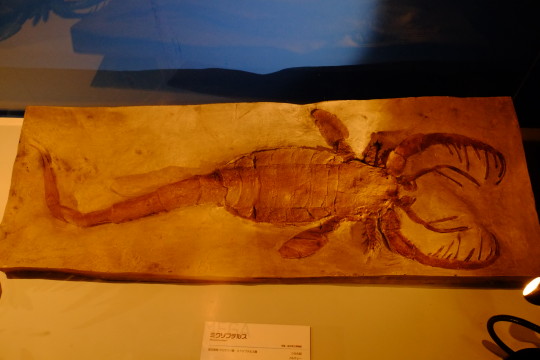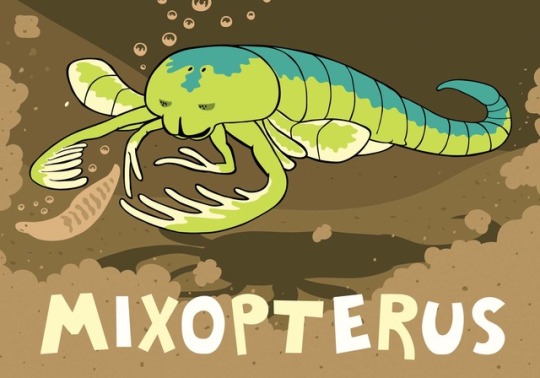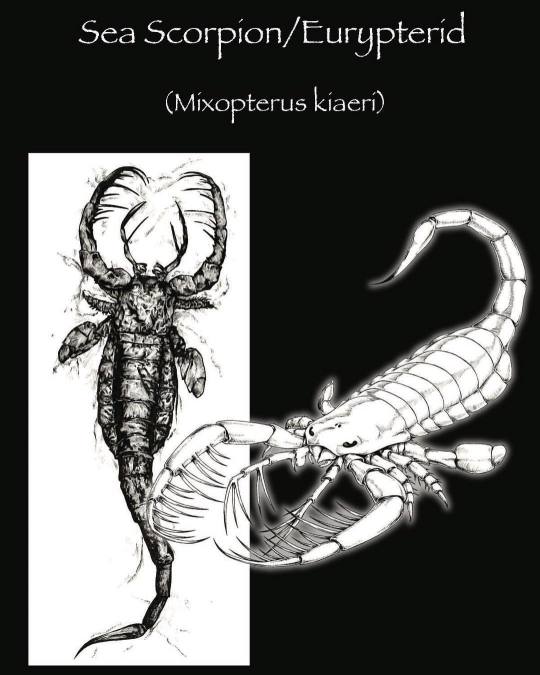#mixopterus
Text


MIXOPTERUS. from my super fresh VIDEO on the Silurian Period
__
Youtube channel
Instagram
54 notes
·
View notes
Text
Splatoon Biology Musings Part 17: Proto-Inkling Ecology
Based on my theories of Inkling/Octoling evolution, then the closest ecological analogy to “wild”, pre-sapience cephalings is not any species of modern cephalopod. Instead, they are more ecologically comparable to eurypterids.

Eurypterids, aka sea scorpions, are a clade of arthropods that first evolved in the Ordovician, over 460 million years ago. They’re closely related to arachnids (spiders, ticks, scorpions, etc.). From the Ordovician through the Devonian, they were very common marine predators, being found all over the globe. The largest known eurypterid, Jaekelopterus, could reach over eight feet in length. They persisted right up until the Great Dying, 252 million years ago.
The anatomy of modern cephalings suggests they may have lived similarly to eurypterids. Take an Inkling in squid form. In contrast with a modern squid, the Inkling’s body is flattened, and the eyes face upwards instead of to the side. These are features that we see in bottom-dwelling predators that that sit on the seafloor, often partially buried, waiting for prey to come by. Some modern examples include flatfish, wobbegongs, and stargazers. And we see these in eurypterids. A few eurypterid lineages share another feature in common with Inklings that bottom-dwelling fish don’t have. In these lineages, one of the limb pairs was specialized into a large pair of arms, with which they caught prey before eating it. Inklings probably used their tentacles for the same thing (note how big they are compared to the other arms).

A comparison between an Inkling and a eurypterid. Eurypterid illustration by Junnn11 on Wikimedia Commons
So aquatic proto-Inklings probably lived like larger eurypterids such as Mixopterus, Megalograptus, and Pterygotus. All of these would have lived in shallow waters, sitting on the seafloor, looking up, waiting. Eurypterids likely partially buried themselves; Inklings may have simply changed color to match the substrate. When prey swam by, they would have popped out from the seafloor, using the largest pair of arms to catch the prey. The other limbs then brought the prey to the mouth to be eaten.
Eurypterids may also provide a model for how Inklings moved onto land. Being bottom-dwellers, eurypterids were common in nearshore environments, and a few lived in freshwater. Several eurypterids were even able to walk on land - we know this from their anatomy and fossil trackways. Once you’re already crawling around the seafloor, going on the shore isn’t that far away. This is probably also how Inklings started exploring land. They came straight from shallow sandy shorelines, and they move on land in a similar way to how they moved on the seafloor.
#splatoon biology musings#splatoon theory#splatoon headcanon#splatoon#splatoon 2#splatoon 3#inkling#my headcanons#oc
145 notes
·
View notes
Note
I had wanted to share my favourite pinchy lad, but when I went to submit the picture I realised all the photos I took at the National Museum Cardiff have been lost. :( Any chance you can provide us with my boy Mixopterus kiaeri?
RIP to this extinct aquatic pinchy pal! They could reach about 2 feet in length.


Photos by ★Kumiko★ and Pavel Bochkov
156 notes
·
View notes
Photo

🦂 Mixopterus kiaeri (Sea Scorpion) 🦂 🦂 🦂 CLASSIFICATION: Phylum- Arthropoda Subphylum- Chelicerata Class- Merostomata Order- Eurypterida (extinct) Family- Mixopteridae (extinct) Genus- Mixopterus (extinct) Species- kiaeri (extinct) 🦂 🦂 🦂 DISTINGUISHING FEATURES: Adult size- 2.45 feet Growth Rate- unknown Lifespan- unknown Temperament- unknown Venom Level- unknown whether this Eurypterid was venomous 🦂 🦂 🦂 DISTRIBUTION: Geographic Range- Euramerica: old continent incorporating much of what is now North America, Europe, & Greenland (fossil discovered north of Oslo, Norway) Habitat Type- marginal marine to brackish water Habit- amphibious 🦂 🦂 🦂 OTHER FACTS: Time Period- Late Silurian 417-354 MYA Diet- primitive fish, trilobites, & other primitive arthropods 🦂 🦂 🦂 For more of my art check out my other Instagram account: @dmn_inspired_evolution 🦂 🕷 🕸 #scorpion #mixopterus #mixopteruskiaeri #seascorpion #eurypterid #chelicerate #chelicerata #eurypterida #scorpionfossil #classification #study #paleontology #entomology #venom #bugs #cheliceratastudy #art
#entomology#art#seascorpion#classification#eurypterida#cheliceratastudy#mixopterus#scorpion#bugs#mixopteruskiaeri#venom#paleontology#scorpionfossil#chelicerate#study#chelicerata#eurypterid
0 notes
Photo

#dinosaurs #jurassicpark #jurassicworld #prehistory #dinosaur #illustration #Mixopterus #cambrian #fossils
My blog: mablox.blogspot.co.uk/
My shop: www.etsy.com/uk/shop/Mablox
0 notes
Photo


Genus: Mixopterus
...a genus of Mixopteroid eurypterids (sea scorpions) that lived during the late Silurian period. Mixopterus was characterized by its robust exoskeleton and claws which held short spines, which likely helped it hold onto 'slippery' prey. Like the unrelated Megalograptus Mixopterus's telson was curved into a spine which gave it a superficial appearance to a scorpion.
Phylogeny
Animalia-Arthropoda-Merostomata-Eurypterida-Mixopteroidea-Mixopteridae-Mixopterus
Images: Nobu Tamura and Ghedoghedo
#Mixopterus#Sea Scorpion#Eurypterid#Eurypterida#Arthropoda#Merostomata#Mixopteroidea#Mixopteridae#Silurian#Extinct#ocean
112 notes
·
View notes
Photo

🦂 Mixopterus kiaeri (Sea Scorpion) 🦂 🦂 🦂 CLASSIFICATION: Phylum- Arthropoda Subphylum- Chelicerata Class- Merostomata Order- Eurypterida (extinct) Family- Mixopteridae (extinct) Genus- Mixopterus (extinct) Species- kiaeri (extinct) 🦂 🦂 🦂 DISTINGUISHING FEATURES: Adult size- 2.45 feet Growth Rate- unknown Lifespan- unknown Temperament- unknown Venom Level- unknown whether this Eurypterid was venomous 🦂 🦂 🦂 DISTRIBUTION: Geographic Range- Euramerica: old continent incorporating much of what is now North America, Europe, & Greenland (fossil discovered north of Oslo, Norway) Habitat Type- marginal marine to brackish water Habit- amphibious 🦂 🦂 🦂 OTHER FACTS: Time Period- Late Silurian 417-354 MYA Diet- primitive fish, trilobites, & other primitive arthropods 🦂 🦂 🦂 For more of my art check out my other Instagram account: @dmn_inspired_evolution 🦂 🕷 🕸 #scorpion #mixopterus #mixopteruskiaeri #seascorpion #eurypterid #chelicerate #chelicerata #eurypterida #scorpionfossil #classification #study #paleontology #entomology #venom #bugs #cheliceratastudy #art
#entomology#art#seascorpion#classification#eurypterida#cheliceratastudy#mixopterus#scorpion#bugs#mixopteruskiaeri#venom#paleontology#scorpionfossil#chelicerate#study#chelicerata#eurypterid
0 notes
Photo

The mixed wings, Mixopterus (1921)
Phylum : Arthropoda
Class : Merostomata
Order : Eurypterida
Superfamily : Mixopteroidea
Family : Mixopteridae
Genus : Mixopterus
Species : M. kiaeri, M. multispinosus, M. simonsoni
Late Silurian (400 Ma)
75 cm long (size)
Norway and North America (map)
Mixopterus were characterised by a robust exoskeletons with scattered tubercles or semicircular scales. The prosoma (head) was subquadrate, protruding antemedially. The chelicerae (claws in front of the mouth) were small. The first two pairs of walking legs were strongly developed, with long paired spines. The third and fourth walking legs were moderately sized, with short spines. The preabdomen, the front portion of the body, was narrow with axial furrows, while the postabdomen was narrow. The telson was a curved spine
8 notes
·
View notes
Photo

PALEO PALS 1 - MIXOPTERUS
not part of the everyday thing but i think i'll post these whenever i do em.
6 notes
·
View notes